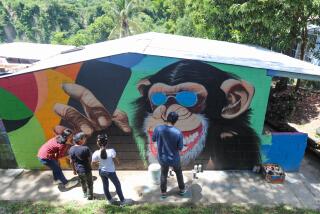Pride of Ownership Finally Takes Root
- Share via
SAN FRANCISCO ANGULO, El Salvador — When Esteban Lopez came home from El Salvador’s civil war six years ago, he was eager to get back to farming after years of fighting.
Within a year, he and 31 of his former guerrilla comrades had received a joint title for a 282-acre ranch. Their property grant was part of the peace agreement that distributed 7% of El Salvador’s arable land to the former combatants, doled out in large parcels because of time constraints set by the accord.
“We divided it up as best we could, with everybody getting a little plot to grow corn to feed their families,” he recalled. “Part of the land was planted in sugar cane, and we worked that together and shared the money when we sold the crop to the sugar mill.”
They worked that way for three years. During that time, no one planted a tree or let a field lie fallow so that it could gather nutrition for the next year’s crop.
“We didn’t know if we were going to keep that land, so why make improvements?” Lopez explained.
That was the problem that experts from CARE, the international relief agency, faced when they tried to talk to Lopez and his neighbors about improving productivity.
“They were not interested because they did not know which parcel of land belonged to whom,” said Rafael Callejas, CARE’s director in El Salvador.
So CARE decided to find out whether giving farmers individual land titles would change their attitudes. With $350,000 from the U.S. government’s Agency for International Development, CARE used satellite technology to survey and subdivide 10 ranches that were part of the land redistribution.
*
Before the 1995 pilot program concluded, the project had attracted enough attention that the Salvadoran government asked CARE to survey 20 more ranches. As part of that expansion, the government provided legal assistance to get the individual land titles registered quickly.
This year, the program’s budget has grown to $26 million, 75% financed by the Salvadoran government and the rest by AID. The goal is to provide individual land titles to all the fighters-turned-farmers who want them in the next four years.
That will require dividing 211,000 acres into 90,000 lots. To complicate matters, some of the land is in areas accessible only by mule--not even dirt bikes can climb there.
But the CARE project has an advantage: its sophisticated satellite technology, which was developed for navigation but has been adapted for surveying.
A surveying team with an antenna and digital mechanism about the size of a radio uses satellite transmissions to plot the points of longitude and latitude marking boundaries. The readings stored in a digital mechanism are fed into a computer, which generates a map that can be drawn over a satellite photograph of the property. The computer also writes the property description, and the two are used in registering the title.
“The possibility of human error is minimal,” Callejas said.
The project offices in the hamlet of Santa Maria Santiago house 21 computer workstations--$4,000 computers that run an $8,000 software package.
The program has four surveying teams now, and a dozen more teams are being trained and are expected to take the field in April.
“One of the project’s side benefits will be the trained professionals it leaves,” Callejas said.
*
But the biggest benefit has been in communities such as San Francisco Angulo, near the Lempa River, where farmers have begun to plant trees and rotate crops on land that they know is theirs.
“Before [getting a property title], you always had to get everyone’s agreement before you could do anything,” said Carmen Romero, a mother of six. “Now, if you want to plant chiles on your land, you plant chiles.”
The farmers still have serious problems: unpaid loans and land that is tired after seven consecutive sugar cane crops.
Getting individual titles, Callejas acknowledged, “is just the first step, but it is the key. There is still a lot more to do.”
More to Read
Sign up for Essential California
The most important California stories and recommendations in your inbox every morning.
You may occasionally receive promotional content from the Los Angeles Times.










